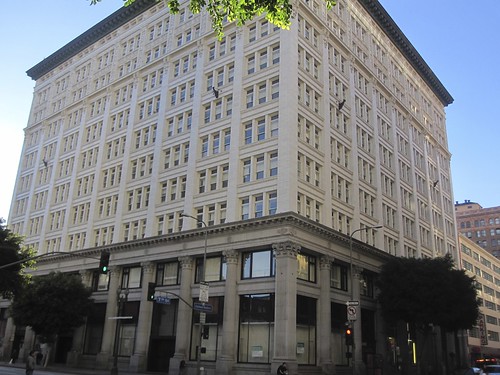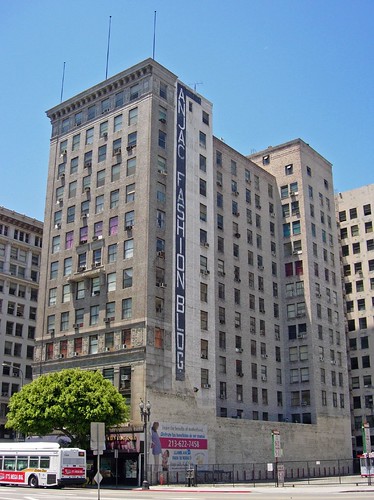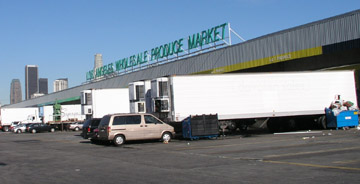Still a great season though. See you in April!
Saturday, October 19, 2013
Wednesday, October 9, 2013
Happy 90th Birthday To The Vista Theatre!
 |
| The Vista Theatre, then and now: 90 years from Baby Peggy to Sandra Bullock. |
Today is the 90th birthday of everybody's favorite old-school theatre - The Vista Theatre, which opened on October 9, 1923 and showed the silent film (well, they were all silent back in the day), Tips (which was filmed locally at the Ambassador Hotel), starring child actress Baby Peggy (who is still alive today at 94). Back then, the theatre was called Bard's East Hollywood Playhouse, one of a chain of local theaters owned by Lou Bard, who also operated a number of theatres in Downtown Los Angeles (The College Theatre, the 8th Street Theatre and the Olympic Theatre). If you look above the marquee in the ornate center window, you can see the letter "B" monogrammed at the top. The "B" stands for "Bard's" (And speaking of "B," B-movie director Ed Wood once had his office behind that window).
Even before it opened, The Vista was literally sitting on Hollywood history: Just across the street was D.W. Griffith's Fine Arts Studio, which stood from 1914 to the early 1960s as a Columbia Pictures facility before being burned down in a fire (the lot is now the Vons Hollywood supermarket). The block where The Vista now stands was the ginormous Babylonian movie set for the 1916 film Intolerance. As you may or may not know, the Babylonian movie set was the architectural inspiration for the Hollywood and Highland shopping center, just 3 miles down the street. The set was torn down in 1919, the property sold and subivided and The Vista was built on the corner of Sunset and Hillhurst. And Hollywood. And Virgil. And Sunset Drive.
In the early 1920s, the discovery of King Tut's treasures in Egypt caused Egyptomania to flood American popular culture. Among them was the construction of Graumann's Egyptian Theatre (now the home of American Cinematheque). Yes, people Walked Like An Egyptian years before The Bangles were even born!
The Vista was no exception. Though the facade was Spanish Revival in design, the interior had a decidedly Egyptian theme. Word to your mummy.
 |
| The monogrammed "B" atop the center window above the marquee stands for "Bard" - the original name and owner of the Vista Theatre. |
Over the years, cinema evolved into various forms from the single-screen, architecturally ornate style of cinema venue form the early days of movies. Sound was introduced, screens got bigger, theatres got larger, screens got even bigger, multiplexes emerged, sound GOT REALLY LOUDER, movies went digital, they went 3-D, and screens got even more ginormous.
But The Vista held on to its old-school, single screen flavor. After a period in the 1960s-1980s The Vista was more (in)famous for ghetto second- and third- run screenings (Though for a time it was popular in '80s-era hipsterness as the Friday night midnight screening venue for The Rocky Horror Picture Show). In 1993 it was purchased by Five Star Theatres (now Vintage Cinemas) who gave it a major restoration from 1997 to 2000. Today it shows first-run pictures (like Gravity starring Sandra Bullock), giving moviegoers an old-school option from the multiplexed-3D-THX-really nasty overpriced popcorn experience of modern cinema.
The theatre isn't doing any 90th-anniversary events, but do stop by to give this old classic a b-day greeting. Maybe in its big Centennial in 2023, we can be treated to a screening of Intolerance and Tips (hopefully Baby Peggy will still be around then) for old time's sake.
Friday, October 4, 2013
The Militant's Epic Militant CicLAvia Tour 6.0 (Or 2.02)!!!!!!
Wel, well, well, we meet again. Time for another wonderful day of sun and smiles, and our third CicLAvia this year. The Militant returns again for yet another Epic Militant CicLAvia Tour, though we may or may not have been to these places before. The Militant has added a few new points of interest, so don't pass this up if you've followed his Epic Militant CicLAvia Tours before.
This route is more or less a mashup of previous routes from last year, which further convolutes The Militant's naming conventions for this particular route. Oh well, it may or may not be the 6th version of the CicLAvia route -- or is it just a variation of the second one? It don't matter. Check it out, check out the sites, spend your dough on food trucks or local businesses, and don't forget your sunscreen. See you or not see you on Sunday!
Note: Though The Militant likes to view the route from west to east for some reason, he has listed these sites from East to West, as some of the sites are related and make a little more sense when going that direction.
East-West Route (Boyle Heights to Mac Arthur Park)
1. Eastside Luv
2006 (Built 1940)
1835 E. 1st St, Boyle Heights
One of The Militant's favorite hangouts in the Eastside, this bar, started by a bunch of friends who grew up in nearby City Terrace, took over the former Metropolitan bar six years ago and updated it to a more contemporary Eastside-style flavor. Don't call it gentrification, call it gentefication.
1889
1st St and Boyle Ave, Boyle Heights
This is the new town square for Boyle Heights, anchored by the historic 1889 Boyle Hotel on the historic Cummings Block, where Mariachi musicians have been hanging out to get picked up for since the 1930s. The Kiosko, or bandstand, that sits in the plaza is actually not that historic. It was given as a gift from the Mexican state of Jalisco, who literally shipped it over in 1998 where it was assembled in place. But it only gets used once a year for the Santa Cecilia Festival around every November 21.
The plaza is also home of the Metro Gold Line station of the same name, which opened in 2009. The unique lending library Libros Schmibros relocated here last year. This place could warrant a Militant blog post in itself -- no, an entire week of posts! Don't miss the Farmers Market events there every Friday and Sunday!
3. Simon Gless Farmhouse
1887
131 S. Boyle Ave., Boyle Heights
Back in the totally radical '80s...That's the 1880s, Boyle Heights was an open, rural area and French Basque immigrant Simon Francois Gless built a Queen Anne style house on his sheepherding farm at this location. Today, the house is a City Historic Cultural Monument and is a home that's rented out to -- Mariachi musicians! Just a few blocks west of here is Gless Street, and you might have heard of Simon's great-granddaughter -- actress Sharon Gless, who starred in the series Cagney and Lacey, which aired a century after her arrière-grand-père first settled in Boyle Heights.
4. Neighborhood Music School
1947 (Built 1890s)
358 S. Boyle Ave, Boyle Heights
The Neighborhood Music School is exactly what it is. But it's also a Boyle Heights institution. Originally founded 98 years ago when it was located on Mozart Street (orchestral rimshot), the school moved to this Victorian home in 1947 where it still offers music lessons to local youth and the public can drop by on weekends to attend free recital concerts.
5. Keiro Retirement Home/Jewish Home For The Aging
1974/1916
325 S. Boyle Ave, Boyle Heights
With Boyle Heights being a historically Jewish and Japanese community, how's this for an ultimate Boyle Heights institution? This property was originally built in 1916 as the Jewish Home for the Aging (now operating in Reseda), and in 1974, the Keiro Senior Health Care organization, basically their Japanese American counterpart. With the Hollenbeck Palms retirement home just down the street (and site of the John Edward Hollenbeck Estate, remember?) Boyle is a popular corridor for Senior Livin.'
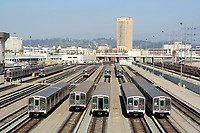 6. Metro Division 20 Subway Car Yard & Site of Old Santa Fe LaGrande Station
6. Metro Division 20 Subway Car Yard & Site of Old Santa Fe LaGrande Station1992 / 1893
320 S. Santa Fe Ave (visible from the 4th Street Viaduct), Arts District
Take a break from riding/walking/skateboarding/pogo-sticking/etc. and take a glance off the north side of the bridge from the west bank of the River. This facility is where the 104 Italian-built subway cars of the Metro Red and Purple line cars are stored, repaired, serviced and cleaned. This was also the temporary storage and repair site of the Angels Flight railway cars after the fateful 2001 accident. The Militant actually visited this facility back in May 1992.
The subway cars are also serviced on the site of the old Santa Fe Railway La Grande Station (hence the name of the street) that was on Santa Fe and 2nd. Built in 1893, it was precisely where midwestern transplants arrived in Los Angeles after paying their $1 train ticket from Chicago. In 1933, the landmark dome was damaged by the Long Beach Earthquake and subsequently removed. In 1939, it was rendered obsolete by the opening of the new Los Angeles Union Passenger Terminal a few blocks north.
7. Site of Quaker Dairy, Original Little Tokyo Restaurant
1890
304 E. 1st St., Little Tokyo
1890
304 E. 1st St., Little Tokyo
On the southeast corner of 1st and San Pedro streets once stood the Quaker Dairy, a restaurant started on this site in 1890 by Sanshichi Akita, an immigrant from Japan. Though preceded five years earlier by another restaurant on First St (location unknown), this is the oldest traceable location of a Little Tokyo business. By the end of the 19th century, there were over 16 Japanese-owned restaurants in this stretch of 1st Street, creating what we know as Little Tokyo.
 8. Los Angeles Sister Cities Monument
8. Los Angeles Sister Cities MonumentCirca late 1980s
1st and Main streets, Downtown
On the northeast corner of 1st and Main streets stands a pole bearing signs (in the "Blue Blade" style, no less) for every one of Los Angeles' 25 Sister Cities, each pointing towards their location. The signs range from Lusaka, Zambia (the farthest sister city, 10,017 miles) to Vancouver, Canada (the nearest, 1,081 miles) and everywhere in between. Nagoya, Japan is Los Angeles' oldest sister city (1959); Yerevan, Armenia is the newest (2007). Los Angeles, an Olympic host city (1932, 1984) also has that in common with sister cities Athens (1896, 2004), Berlin (1936), Mexico City (1968) and Vancouver (2010). Okay, the Militant is just filling up this paragraph with mindless trivia.
9. New Los Angeles City "Chevy Logo" Street Signs
2009
Various locations along 1st Street, Downtown
Speaking of Blue Blades, and since you're on 1st Street, don't forget to see Los Angeles' new street signs! Featuring a reflective background and typeface, the City Seal and shaped like the Chevrolet logo, these were the subject of The Militant's now-legendary recent post on Los Angeles street signs. Now you can see them for yourself!
10. Los Angeles Police Administration Building
2009
100 W. 1st St, Downtown
Having opened less than two years ago, there's nothing really historic about this building, but do stop and take a picture of City Hall's reflection from the facade's glass panel. It's like, the thing to do.
Ever wonder about that park-like area across the street from City Hall, and why there appears to be a foundation but no building? It was once the site of the State Office Building (pictured left, looking north on Spring), which was built in 1931. Forty years later, the 6.4 Sylmar Earthquake rendered it unsafe, and it was demolished. The land was once an openly-accessible parkspace; the Militant remembers going to a demonstration there as a child (Oh this Militant stuff sure started early...)
• If heading on north leg towards Chinatown, skip to #22.
• If heading on north leg towards Chinatown, skip to #22.
 12. Site of the Wilcox Building, First National Bank
12. Site of the Wilcox Building, First National Bank1896
2nd and Spring streets, Downtown
Remember Mr. Hollenbeck? He be makin' serious bank! Oh wait, he literally did. As was mentioned, he founded a bank called the First National Bank of Los Angeles, which made its original home here on the southeast corner of 2nd and Spring in what once stood the Wilcox Building. Check this out: First National Bank merged with the Farmers and Merchants Bank to become the Security-First National Bank, which became Security Pacific National Bank (1967), and was eventually purchased by Bank of America in the 199os.
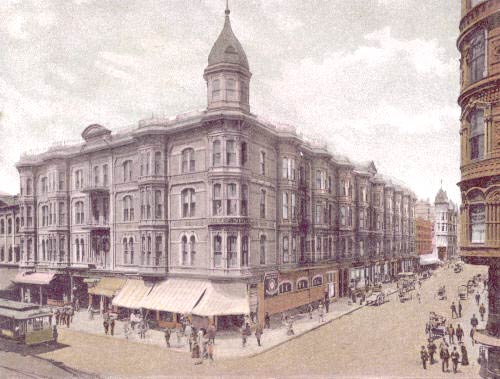 13. Site of Hollenbeck Hotel
13. Site of Hollenbeck Hotel1884
2nd and Spring streets, Downtown
Man, this Hollenbeck dude got around! We're not quite through with him yet. Directly across Spring Street from the bank (on what is now a parking lot) stood the Hollenbeck Hotel, a pretty swanky, bougie inn back in the day. He owned not just the hotel, the entire block the hotel stood on (He sooo money!). As more hotels were being built in Downtown, this one eventually lost ground to its competitors and was demolished in 1933.
 14. Site of Original Ralphs Supermarket
14. Site of Original Ralphs Supermarket1873
6th and Spring streets, Downtown
Before the Hotel Hayward building was built in 1905, George A. Ralphs (see, that's why there's no apostrophe) and his brother Walter B. started the Ralphs Bros. Grocers on the southwest corner of 6th and Spring. Their company still continues to this day, and in 2007, the company that started in DTLA returned to the area after some 50 years.
• If heading on south leg towards South Los Angeles, skip to #26.
15. St. Vincent Court
1868
St. Vincent Ct and 7th Street, Downtown
You'd hardly knew it was there, but this alley nestled between Broadway and Hill (blink and you'll miss it!), with its decorative brick pavement and European decor, seemingly belongs to another world. Originally the site of a Catholic college that was the predecessor of today's Loyola Marymount University, today it's a unique food court featuring Armenian and Middle Eastern eateries. The Militant calls it, "Littler Armenia." Check out this Militant Angeleno post on St. Vincent Court from 2008 for more info!
16. Wilshire Grand Hotel Site
2017
Wilshire and Figueroa (SW corner), Downtown
Up until several months ago on that empty lot was the Wilshire Grand Hotel, formerly (in reverse chronological order) the Omni Hotel, Los Angeles Hilton, Statler Hilton and Statler Hotel.
On this site will rise Los Angeles' (and the West's -- suck on it, Transbay Tower SF!) tallest building at 73 stories and 1,100 feet (kinda sorta, there's a spire, you see...). It will also be Los Angeles' only modern skyscraper without a flat roof. It will house Wilshire Grand Hotel 2.0 and a bunch of shops and condos.
The building will also have a "sky lobby" up at the top and will be the first skyscraper anywhere to sport a mohawk.
 17. City View Lofts/Young's Market Company Building
17. City View Lofts/Young's Market Company Building1924
1610 w. 7th St., Pico-Union
Ever wondered what's the deal with this 4-story Italian Renaissance-style building? It was built in 1924 as a liquor warehouse and original headquarters for Young's Market Company, which still operates today as the largest liquor distributor in the West. This building features actual marble columns and a decorative frieze made of terra cotta. The company, in the roaring, pre-depression 1920s, just felt like it. The building was looted and burned in the 1992 Riots and was rehabbed in 1997 to become the City View lofts. The building is in the National Register of Historic Places.
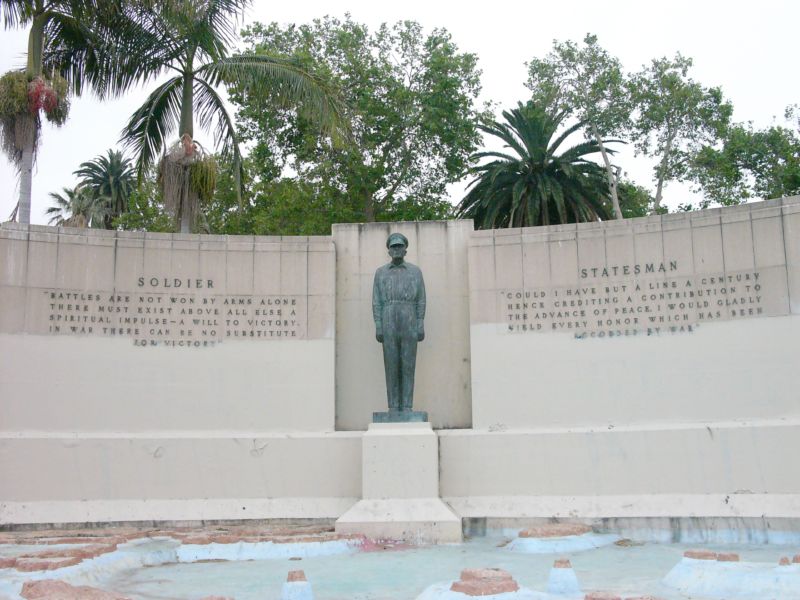 18. Gen. Douglas MacArthur Monument
18. Gen. Douglas MacArthur Monument1955
Southeast corner of MacArthur Park, Westlake
It's sort of strange how a monument to the park's namesake seems almost invisible (Gen John Pershing, MacArthur's WWI counterpart, could totally identify). In fact, most people don't know it's even there, but on the southeast shore of the lake is a dormant memorial fountain featuring a statue of the WWII general overlooking a model of the Pacific theatre (no, not that one) where he led allied forces to eventual victory. It was designed and built in 1955 by Roger Noble Burnham, who previously sculpted the Tommy Trojan statue on the USC campus and taught at the Otis Art School, formerly located nearby.
Northern Route (To Chinatown):
19. Grand Park
1960, 2012
Open space between Grand Avenue and Spring Street, Downtown
Grand Park isn't really a new park, but a renovation and re-branding of what used to be the Los Angeles County Mall. Since then, it's become Los Angeles' new town square, hosting everything from concerts, to festivals, to weekend movie screenings, to holiday programs, to just a place where kids can splash around in the fountain. The Militant was there on its opening day back in July 2012!
20. Hall Of Justice
1926
Temple Street and Broadway, Downtown
No, you won't find Superman or any of the Super Friends here. But this building, the oldest surviving government building in the Los Angeles Civic Center, was built in the mid-1920s as the original Los Angeles County Courthouse and Central Jail (which once housed the likes of Busy Siegel, Sirhan Sirhan and Charles Manson), as well as the headquarters for the Sheriff's Office, the District Attorney and the County Coroner. This Beaux Arts-style building was designed by Allied Architects Association, an all-star team of local architects put together to design publicly-funded buildings. At the moment, its facade is covered in scaffolding and tarp, as part of a major renovation project to modernize the facilities and repair damage from the 1994 Northridge Earthquake. It is slated to re-open as a LEED Gold Certified building (gotta be sustainable, y'all) in 2015, and the Sheriff's and District Attorney's offices will return.
21. Site of Los Angeles' French Quarter
c. 1830s-1960s
Aliso Street and Arcadia Street, Downtown
Beleive it or non, Los Angeles had a French ethnic enclave, called The French Quarter. Before today's Hollywood Freeway trench and nearby parking lots was a bustling community of Franco-American businesses and institutions. When Frenchman Jean-Louis Vignes bought up land on the Yangna village site a few blocks east on Aliso Street, he essentially became the anchor of our French community. In 1912, businessman Marius Taix opened the Champ D'Or Hotel on Commercial Street and then opened his namesake restaurant in the same building in 1927. But the most famous constibution to our French Quarter was Philippe Mathieu's restaurant, which opened in various locations in the area. In 1918, his restaurant on 246 Aliso Street gave birth to The French Dip sandwich. But urban development (and cultural assimilation by the community) destroyed the French Quarter. In 1951, Philippe's moved a few blocks north to their present location on Alameda Street due to Hollywood Freeway construction, and Monsieur Taix's restaurant moved a decade later to Echo Park.
22. Chinatown Gateway Monument
2001
Broadway and Cesar E. Chavez. Avenue, Chinatown
Designed to be the symbolic entrance to Los Angeles' Chinatown District, The Chinatown Gateway Monument, a.k.a. the Twin Dragon Towers Gateway, depicts two dragons grabbing at a central pearl, which symbolizes luck, prosperity, and longevity. The 25-foot-tall structure was put up in 2001 and occasionally emanates steam coming from the dragons' mouths. Unlike Anglo dragons, the creatures in Chinese folklore are the good guys, meant to scare away evil spirits.
23. Buu Dien
c. 1990s
642 N. Broadway (Facing New High St, south of Ord), Chinatown
If you're ever in some TV trivia contest on your way to being a millionaire and the host asks you, "What is the Militant Angeleno's favorite Vietnamese banh mi place west of the Los Angeles River?" you won't need to call a lifeline, because the answer is Buu Dien. When the Militant has only $4 in his pocket and wants to get a meal in Downtown, this is his go-to joint. A literal hole in the wall in every regard, this place serves bomb-ass (do people still use that phrase) Viet sammiches for less than $3 a pop. And the bread is awesome. And nice and warm. Plus they also serve up spring rolls, desserts, pastries, Vietnamese coffee and pho (never had it here yet, but The Militant's favorite pho WOTLAR is Pho 79 just up the street). People complain about parking in his micro-mini mall, but this is CicLAvia!
24. Capitol Milling Co.
1883
1231 N. Spring St, Chinatown
One of the last visible vestiges of Los Angeles' agricultural industry, this family-owned flour mill operated from 1831 to 1997, before moving its operation to a much larger facility in Colton. The facility that still stands today was built in 1883. The mill supplied flour to clients such as Ralphs, Foix French Bakery and La Brea Bakery. In 1999, the family-owned operation was purchased by industry giant Con-Agra Co.
The historic building, built even before the railroads arrived in Los Angeles, still has a horse-tethering ring, back to the days when grain was hauled by horse carriage from farms in the San Fernando Valley.
25. Old (New?) Chinatown Central Plaza
1937
Gin Ling Way between Broadway and Hill, Chintown
The new northern terminus of CicLAvia is no stranger to public events; it was made for them. In the Summer it hosted three very popular Chinatown Summer Nights events. But don't let the "Old Chinatown" neon sign fool you -- This is actually Los Angeles' new Chinatown, which dates back to the 1930s. The real Old Chinatown was several blocks south, where a thriving community of Cantonese-speaking immigrants
lived near the river, north of Aliso Street. Of course, they were kicked out in the early '30s to make room for Union Station. So they moved a few blocks north, in the former Little Italy, and they've been there ever since. Well, not really, since some of them moved east to the San Gabriel Valley and were supplemented with Mandarin-speaking immigrants from Taiwan and Mainland China. But you get the idea.
26. The I.N. Van Nuys Building
1911
210 W. 7th St (at Spring), Downtown
A 100-year old, 11-story Classical-style building built by banker and landowner Isaac Newton Van Nuys (who owned much of the San Fernando Valley, including his eponymous community). Designated as a Historic Cultural Landmark (#898) in 2007, what was once Los Angeles' most expensive office building ($1.25 million in 1911 dollars) was converted to senior housing. Do check out its unique parking structure, at 719-721 S. Spring St.
27. Great Republic Life Insurance Building
1927
756 S. Spring St., Downtown
The Militant just loves old buildings with their names imprinted on their front and ornate bas-relief designs in the upper financial floors. This 13-story Beaux Arts style building is one of those, home to the Great Republic Life Insurance company, built right before the Great Dperession. This and many other financial institutions up and down Spring Street were part of the "Wall Street of the West." And since this is 2011, think of CicLAvia as #OccupyWallStreetOfTheWest. Today, it's home to the Great Republic Lofts.
28. National City Bank Building
1924
810 S. Spring St., Downtown
Another fine example of 1920s Beaux Arts architecture is the National City Bank (not to be confused with the City National Bank) Building. They just don't make 'em like this anymore. Today, it's home to the National City Tower Lofts.
29. ANJAC Fanshion Buildings
Built various years in the 20th Century
Various Locations along Broadway, Spring and Santee Streets, Downtown
The ANJAC Fashion Buildings (you'll see a whole bunch of 'em) are a collection of older buildings re-purposed for use as rented showroom, warehouse or manufacturing spaces for the local clothing industry. They're all owned by Steve Needleman, who also owns the nearby Orpheum Theatre. One of the ANJAC buildings on nearby Broadway was the site of an historic 3-week garment worker's strike in 1933 that put Chicano organized labor on the map.
30. Spring/Main Junction
c 1890s
Spring and Main Streets at 9th Street, Downtown
This very Manhattanesque portion of Downtown Los Angeles might not be The Great White Way, but it did serve as a junction point for both the Pacific Electric and Los Angeles Railway trolleys back in the day. The triangular park in the middle, recently ornamented with public art once served as a passenger platform for the streetcars. The building at the very tip of the corner, just north of it was once the local Anheuser Busch brewing company headquarters. More historical pics here, here, here and here.
31. Harris Newmark Building
This 12-story building was at one time the tallest building in Los Angeles, built in honor of Harris Newmark, an early Los Angeles leader, businessman, landowner and philathropist. He helped to found the city of Montebello and helped shape Los Angeles' Jewish community through his leadership and charitable giving. It was once home to Sam's Deli, a local eatery institution that operated from 1963 to 2003. In the '90s, the building was carefully restored using the original blueprints. It now functions today as The New Mart (get it?)
9th and Cecilia streets, Downtown
Now here's a sight that longtime Angelenos haven't seen in a long time - the interlocking "S" logo of Security Pacific National Bank. Once upon a time, there were actually large banks founded and headquartered in Los Angeles. Security Pacific, a major bank whose heritage dates back to 1868 was swallowed up by the big, evil Bank of America in 1992. The Militant discovered recently that this apparent vestige of days gone by is actually more recent, as a new but unrelated Security Pacific began in 2005 and went out of business just three years later (the bank space in this building is vacant and currently available for lease). Judging by the condition of the sign, this may or may not be the case.
33. Dude, Where's My 9th Street?
1928
9th Street-Olympic Blvd at Ceres Ave.
Chalk this one up, along with the two San Vicente Boulevards, as one of the great street mysteries of Los Angeles. While heading east on 9th Street, the thoroughfare inexplicably becomes Olympic Boulevard, only to vanish into oblivion. Olympic, on the other hand, resurfaces west of San Julian and heads all the way Santa Monica's 5th Street. The Militant is only announcing this as a public service just so you won't think anyone was f'ing with your mind as you head east on 9th.
1227 E. Olympic Blvd, Downtown
This wholesale market operated in partial competition to the much larger wholesale market just a few blocks east, but it's in a supplementary role nowadays as a wholesale meat and poultry facility.
Central and Olympic Blvd, Downtown
Anyone who says Los Angeles, or even Downtown Los Angeles, isn't a 24-hour city, has obviously never been here. From about 2 a.m. to 2 p.m. (the action begins at 4 a.m. and ends before 10 a.m.), trucks roll up to unload fresh-from-the-farm produce in bulk for purchase. This market is mostly for supermarkets, distributors and restaurants, but anyone can purchase at the vendors here (you just have to take home a big-ass crate of apples rather than just a couple pounds). The Grand Central Market performed this role all but briefly before it was maxed out, and a new produce market, on 7th and Central was built closer to the railroad tracks in 1918. In 1986, the facility was expanded to what you see today. Check out this YouTube video of how the market looked like in 1963!
12th Street at Central Avenue, Downtown
Look at the cracks and crevices in the street, just east of the crosswalk: TRACK! These tracks carried the Yellow Cars of the Los Angeles Railway's 2 Line, which ran from South Central through Downtown to the City Terrace area in The Eastside. Look carefully and you can see the old school inlaid brickwork in between the tracks! And unlike #26 above, the tracks are verified to be there!
1936
1334 S. Central Ave, Downtown
Coca-Cola has been locally bottled in Los Angeles since 1895, with about five different locations in the Downtown area throughout history. But this is by far the most recognizable. A ship-like design by Robert Derrah (who also crafted Hollywood's likewise-nautical-flavored Crossroads Of The World) makes this one of Los Angeles' most unique buildings. And they'll be handing out free Coke and related beverage samples!
1401 S. Central Ave, Downtown
Originally built as LAFD fire station 30, it was one of two "Blacks Only" stations between 1924 and 1955, when the fire department was integrated and the station de-commissioned. In 1997 the building was converted into a museum to celebrate the contributions of African Americans in the LAFD and to highlight the long and painful struggle to integration and racial equality. The LAFD of today has a black Fire Chief, which would never have been possible without the struggles, stories and service of the people recognized at this museum. Definitely check it out.
210 W. 7th St (at Spring), Downtown
A 100-year old, 11-story Classical-style building built by banker and landowner Isaac Newton Van Nuys (who owned much of the San Fernando Valley, including his eponymous community). Designated as a Historic Cultural Landmark (#898) in 2007, what was once Los Angeles' most expensive office building ($1.25 million in 1911 dollars) was converted to senior housing. Do check out its unique parking structure, at 719-721 S. Spring St.
27. Great Republic Life Insurance Building
1927
756 S. Spring St., Downtown
The Militant just loves old buildings with their names imprinted on their front and ornate bas-relief designs in the upper financial floors. This 13-story Beaux Arts style building is one of those, home to the Great Republic Life Insurance company, built right before the Great Dperession. This and many other financial institutions up and down Spring Street were part of the "Wall Street of the West." And since this is 2011, think of CicLAvia as #OccupyWallStreetOfTheWest. Today, it's home to the Great Republic Lofts.
28. National City Bank Building
1924
810 S. Spring St., Downtown
Another fine example of 1920s Beaux Arts architecture is the National City Bank (not to be confused with the City National Bank) Building. They just don't make 'em like this anymore. Today, it's home to the National City Tower Lofts.
29. ANJAC Fanshion Buildings
Built various years in the 20th Century
Various Locations along Broadway, Spring and Santee Streets, Downtown
The ANJAC Fashion Buildings (you'll see a whole bunch of 'em) are a collection of older buildings re-purposed for use as rented showroom, warehouse or manufacturing spaces for the local clothing industry. They're all owned by Steve Needleman, who also owns the nearby Orpheum Theatre. One of the ANJAC buildings on nearby Broadway was the site of an historic 3-week garment worker's strike in 1933 that put Chicano organized labor on the map.
30. Spring/Main Junction
c 1890s
Spring and Main Streets at 9th Street, Downtown
This very Manhattanesque portion of Downtown Los Angeles might not be The Great White Way, but it did serve as a junction point for both the Pacific Electric and Los Angeles Railway trolleys back in the day. The triangular park in the middle, recently ornamented with public art once served as a passenger platform for the streetcars. The building at the very tip of the corner, just north of it was once the local Anheuser Busch brewing company headquarters. More historical pics here, here, here and here.
31. Harris Newmark Building
1925
127 E. 9th St., DowntownThis 12-story building was at one time the tallest building in Los Angeles, built in honor of Harris Newmark, an early Los Angeles leader, businessman, landowner and philathropist. He helped to found the city of Montebello and helped shape Los Angeles' Jewish community through his leadership and charitable giving. It was once home to Sam's Deli, a local eatery institution that operated from 1963 to 2003. In the '90s, the building was carefully restored using the original blueprints. It now functions today as The New Mart (get it?)
32. Security Pacific Bank(!)
c 1990s or 2000s9th and Cecilia streets, Downtown
Now here's a sight that longtime Angelenos haven't seen in a long time - the interlocking "S" logo of Security Pacific National Bank. Once upon a time, there were actually large banks founded and headquartered in Los Angeles. Security Pacific, a major bank whose heritage dates back to 1868 was swallowed up by the big, evil Bank of America in 1992. The Militant discovered recently that this apparent vestige of days gone by is actually more recent, as a new but unrelated Security Pacific began in 2005 and went out of business just three years later (the bank space in this building is vacant and currently available for lease). Judging by the condition of the sign, this may or may not be the case.
1928
9th Street-Olympic Blvd at Ceres Ave.
Chalk this one up, along with the two San Vicente Boulevards, as one of the great street mysteries of Los Angeles. While heading east on 9th Street, the thoroughfare inexplicably becomes Olympic Boulevard, only to vanish into oblivion. Olympic, on the other hand, resurfaces west of San Julian and heads all the way Santa Monica's 5th Street. The Militant is only announcing this as a public service just so you won't think anyone was f'ing with your mind as you head east on 9th.
34. Central Market
c 1930s1227 E. Olympic Blvd, Downtown
This wholesale market operated in partial competition to the much larger wholesale market just a few blocks east, but it's in a supplementary role nowadays as a wholesale meat and poultry facility.
35. Los Angeles Wholesale Produce Market
1918, expanded in 1986Central and Olympic Blvd, Downtown
Anyone who says Los Angeles, or even Downtown Los Angeles, isn't a 24-hour city, has obviously never been here. From about 2 a.m. to 2 p.m. (the action begins at 4 a.m. and ends before 10 a.m.), trucks roll up to unload fresh-from-the-farm produce in bulk for purchase. This market is mostly for supermarkets, distributors and restaurants, but anyone can purchase at the vendors here (you just have to take home a big-ass crate of apples rather than just a couple pounds). The Grand Central Market performed this role all but briefly before it was maxed out, and a new produce market, on 7th and Central was built closer to the railroad tracks in 1918. In 1986, the facility was expanded to what you see today. Check out this YouTube video of how the market looked like in 1963!
36. Yellow Car Tracks
c. early 1900s12th Street at Central Avenue, Downtown
Look at the cracks and crevices in the street, just east of the crosswalk: TRACK! These tracks carried the Yellow Cars of the Los Angeles Railway's 2 Line, which ran from South Central through Downtown to the City Terrace area in The Eastside. Look carefully and you can see the old school inlaid brickwork in between the tracks! And unlike #26 above, the tracks are verified to be there!
 |
1334 S. Central Ave, Downtown
Coca-Cola has been locally bottled in Los Angeles since 1895, with about five different locations in the Downtown area throughout history. But this is by far the most recognizable. A ship-like design by Robert Derrah (who also crafted Hollywood's likewise-nautical-flavored Crossroads Of The World) makes this one of Los Angeles' most unique buildings. And they'll be handing out free Coke and related beverage samples!
38. African American Firefighter Museum (Fire Station 30)
1913, 19971401 S. Central Ave, Downtown

















